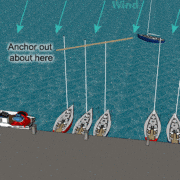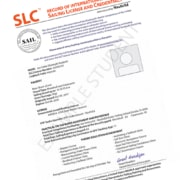How to do a Mediterranean Mooring when the wind is nose on
First, what is a Mediterranean Mooring? Well it can be done anywhere but you mostly see it in the Med where it is required that you back the boat up to a (typically) concrete quay. You either anchor out and back the boat up to the wall OR back the boat up to the wall and pick up a mooring line. Both the anchor or the mooring line help to hold your boat off the concrete wall. Aft dock lines hold your boat’s stern close to the wall. It’s an easy maneuver but you need to practice it.
Mediterranean Mooring when the wind is pushing you into the wall.
This is a slightly tricky one, not quite as difficult as a side wind, but tricky none the less. To simplify, use the technique below.
From our Maneuvering and Docking a Sailboat Under Power course, you know that backing downwind is not the easiest especially in high winds. You need to start out with the stern into the wind and then put into reverse. This gets the boat moving with water washing over the rudder to gain steerage and then turn the boat clockwise (stern to port) so that you are using the propwalk effect. Once the stern is pointing downwind you have to keep the speed up to overcome the propensity of the wind to push the bow down.
If you combine all that with dropping the anchor at exactly the right moment and pay out the anchor rode fast enough so as to not slow down the boat you’ve got a potentially difficult situation where everything has to come together perfectly. Which btw never happens!!!
So the plan is to make this downwind Mediterranean Mooring task simple.

How to do a Mediterranean Mooring Downwind
(1) Motor the boat to the place where you think the anchor should be. Eventually, for holding power, you will want as much rode out as practically possible. Use boat lengths to judge the distance. If you have 200 feet of rode and a 40-foot boat, then you should drop the anchor 5 boat lengths out (minus 1 foot LOL).
(2) At the place you deem appropriate, drop enough so that the anchor is on the bottom but not a ton on rode sitting on top of itself; just enough to not let the anchor drag as the boat is pushed downwind.
(3) Allow the boat to be pushed downwind towards the slip. The boat bow will naturally face the wind since the anchor is holding the bow windward.
(4) Pay out anchor rode to allow the boat to drift backwards downwind towards the slip.
(5) Use the engine to maneuver the boat slightly as needed.
(6) Toss long aft docklines ashore to helpful hands on the dock. Tie those off and use forward gear propwash against the rudder to push the stern of the boat as needed to position correctly. See the animation below.
(7) When the stern is aligned to the correct slot pay out more rode and use reverse. The anchor-person controls the rate the boat moves backwards.
(8) Continue to tighten the aft docklines until the vessel is 2-3 feet from the quay wall. Synch up on the anchor line tight enough so that no boat wakes can wash the boat up against the quay wall. Monitor for a while.
(9) Run out the plank – now walk the plank ya’ scally wag and enjoy a local cafe.
What we also find is that you won’t be in exactly the right place and you will need to lever your boat sideways, even into wind. Using a dockline and wash over rudder you can push the boat sideways however you want. Watch this animation.
Did you find this useful?
Take our Maneuvering Under Power course – you’ll impress people at the dock and keep the gel coat on your boat.
- RYA Day Skipper with NauticEd - April 1, 2024
- NauticEd uses the SailTies GPS Tracking App - March 29, 2024
- Sea of Cortez Flotilla – February 2025 - March 8, 2024






